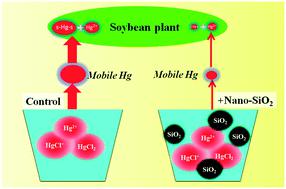当前位置:
X-MOL 学术
›
Environ. Sci.: Nano
›
论文详情
Our official English website, www.x-mol.net, welcomes your feedback! (Note: you will need to create a separate account there.)
Silica nanoparticles alleviate mercury toxicity via immobilization and inactivation of Hg(II) in soybean (Glycine max)
Environmental Science: Nano ( IF 7.3 ) Pub Date : 2020-04-30 , DOI: 10.1039/d0en00091d Yunyun Li 1, 2, 3, 4, 5 , Nali Zhu 6, 7, 8, 9, 10 , Xujun Liang 4, 11, 12, 13, 14 , Xu Bai 4, 5, 9, 15, 16 , Lirong Zheng 4, 5, 9, 15, 16 , Jiating Zhao 4, 5, 9, 15, 16 , Yu-feng Li 4, 5, 9, 15, 16 , Zhiyong Zhang 4, 5, 9, 15, 16 , Yuxi Gao 4, 5, 9, 15, 16
Environmental Science: Nano ( IF 7.3 ) Pub Date : 2020-04-30 , DOI: 10.1039/d0en00091d Yunyun Li 1, 2, 3, 4, 5 , Nali Zhu 6, 7, 8, 9, 10 , Xujun Liang 4, 11, 12, 13, 14 , Xu Bai 4, 5, 9, 15, 16 , Lirong Zheng 4, 5, 9, 15, 16 , Jiating Zhao 4, 5, 9, 15, 16 , Yu-feng Li 4, 5, 9, 15, 16 , Zhiyong Zhang 4, 5, 9, 15, 16 , Yuxi Gao 4, 5, 9, 15, 16
Affiliation

|
Mercury (Hg) pollution is a worldwide concern. Silica nanoparticles (nano-SiO2) can be released into ecosystems through natural and anthropogenic (engineered nano-SiO2) processes. Here, the influence of two sizes (30 nm and 50 nm) of artificial nano-SiO2 on Hg accumulation in soybean plants, the chemical form and distribution of Hg in plant tissues and the levels of chlorophyll and antioxidant enzymes in plants were investigated. The results showed that both sizes of nano-SiO2 amendments alleviated the growth inhibition induced by Hg and reduced the accumulation (62.2–83.6% in roots; 67.9–75.7% in stems; 45.0–70.7% in leaves lower with nano-SiO2 amendments vs. Hg-only exposure) and translocation (transport rates: 0.18–0.19 with nano-SiO2 amendments vs. 0.22–0.26 Hg-only exposure) of Hg in soybean seedlings. Compared with the Hg-only exposed groups, nano-SiO2 amendments significantly reduced the Hg concentrations in the epidermis and pericycle of the roots and stems, especially the pericycle measured by synchrotron radiation X-ray fluorescence (SRXRF). The application of nano-SiO2 also ameliorated the chlorophyll decrease (15.3–50.1% higher with nano-SiO2 amendments vs. Hg-only exposure) and antioxidant enzyme increase (20.7–33.2% lower with nano-SiO2 amendments vs. Hg-only exposure) induced by Hg stress. Additionally, the RS–Hg–SR bonding form in the roots of nano-SiO2 treated groups significantly decreased when compared with that of Hg-only exposed groups, and over 85% of the total Hg content was present in the form of R–Hg–Cl, which was largely consistent with the original Hg exposure species and indicated a low incorporation rate of Hg into plant tissues. This study explored the mechanism of nano-SiO2 against Hg toxicity in plants, and offered a new passivating agent option for Hg remediation.
中文翻译:

二氧化硅纳米颗粒通过固定和灭活大豆中的Hg(II)减轻汞毒性(最大大豆)
汞(Hg)污染是全球关注的问题。二氧化硅纳米粒子(纳米SiO 2)可以通过自然和人为(工程化纳米SiO 2)过程释放到生态系统中。在此,研究了两种尺寸(30 nm和50 nm)的人造纳米SiO 2对大豆植物中Hg积累,植物组织中Hg的化学形式和分布以及植物中叶绿素和抗氧化酶水平的影响。结果表明,两种尺寸的纳米SiO 2修饰剂均减轻了汞诱导的生长抑制并减少了积累(根部为62.2–83.6%;茎为67.9–75.7%;叶片为45.0–70.7%,纳米SiO 2较低修正与汞仅曝光)和转运(运输率:0.18-0.19与纳米二氧化硅2个修正案对大豆幼苗0.22-0.26汞仅曝光)汞柱。与仅暴露汞的基团相比,纳米SiO 2修饰剂显着降低了根和茎的表皮和周周中的Hg浓度,尤其是通过同步辐射X射线荧光(SRXRF)测量的周周。纳米二氧化硅的应用2还改善的叶绿素减少(高15.3-50.1%具有纳米的SiO 2条的修正与汞仅曝光)和抗氧化酶的增加(与纳米的SiO 20.7-33.2%降低2个修正与由汞压力引起的仅汞暴露)。此外,与仅暴露于汞的暴露组相比,纳米SiO 2处理组根中的RS–Hg–SR结合形式显着减少,并且超过85%的总汞含量以R–形式存在Hg–Cl,与最初的汞暴露量基本一致,表明汞向植物组织的掺入率较低。这项研究探索了纳米SiO 2对抗植物中Hg毒性的机理,并为Hg的修复提供了一种新的钝化剂选择。
更新日期:2020-06-18
中文翻译:

二氧化硅纳米颗粒通过固定和灭活大豆中的Hg(II)减轻汞毒性(最大大豆)
汞(Hg)污染是全球关注的问题。二氧化硅纳米粒子(纳米SiO 2)可以通过自然和人为(工程化纳米SiO 2)过程释放到生态系统中。在此,研究了两种尺寸(30 nm和50 nm)的人造纳米SiO 2对大豆植物中Hg积累,植物组织中Hg的化学形式和分布以及植物中叶绿素和抗氧化酶水平的影响。结果表明,两种尺寸的纳米SiO 2修饰剂均减轻了汞诱导的生长抑制并减少了积累(根部为62.2–83.6%;茎为67.9–75.7%;叶片为45.0–70.7%,纳米SiO 2较低修正与汞仅曝光)和转运(运输率:0.18-0.19与纳米二氧化硅2个修正案对大豆幼苗0.22-0.26汞仅曝光)汞柱。与仅暴露汞的基团相比,纳米SiO 2修饰剂显着降低了根和茎的表皮和周周中的Hg浓度,尤其是通过同步辐射X射线荧光(SRXRF)测量的周周。纳米二氧化硅的应用2还改善的叶绿素减少(高15.3-50.1%具有纳米的SiO 2条的修正与汞仅曝光)和抗氧化酶的增加(与纳米的SiO 20.7-33.2%降低2个修正与由汞压力引起的仅汞暴露)。此外,与仅暴露于汞的暴露组相比,纳米SiO 2处理组根中的RS–Hg–SR结合形式显着减少,并且超过85%的总汞含量以R–形式存在Hg–Cl,与最初的汞暴露量基本一致,表明汞向植物组织的掺入率较低。这项研究探索了纳米SiO 2对抗植物中Hg毒性的机理,并为Hg的修复提供了一种新的钝化剂选择。


























 京公网安备 11010802027423号
京公网安备 11010802027423号